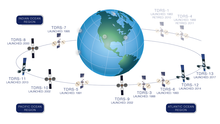TDRS-8
It was the first Tracking and Data Relay Satellite, of second generation, to be launched.Due to a malfunction of the multiple-access phased array antenna the spacecraft did not provide the expected level of performance for eighteen of the communications services that it was to provide.The same problem was found and corrected on the TDRS-9 and TDRS-10 satellites prior to their launches.Following its launch, it raised itself into geostationary orbit by means of its onboard R-4D apogee motor, and was positioned at 150.0° West for on-orbit testing.After testing was complete, it was moved to 171.0° East from where it provides communications services to spacecraft in Earth orbit, including the Space Shuttle and International Space Station.


CommunicationCOSPAR IDSATCAT no.BSS-601BoeingAtlas IICape CanaveralLC-36AGeocentric orbitGeostationary orbitcommunications satelliteTracking and Data Relay Satellite Systemsatellite busInternational Launch Serviceslaunch vehicleLaunch Complex 36ACape Canaveral Air Force StationTracking and Data Relay SatelliteTDRS-9TDRS-10apogee motorSpace ShuttleInternational Space Station2000 in spaceflightList of TDRS satellitesJonathan's Space ReportTDRS-1TDRS-BTDRS-3TDRS-4TDRS-5TDRS-6TDRS-7TDRS-11TDRS-12TDRS-13← 1999Orbital launches in 20002001 →Galaxy 10RJAWSATFalconSAT-1Progress M1-1Hispasat 1CASTRO-ESTS-99Garuda 1Superbird-B2Ekspress A2INSAT-3BAsiaStarSoyuz TM-30SESAT 1Galaxy 4RProgress M1-2GOES 11USA-150STS-101Eutelsat W4Ekspress A3Fengyun 2BSNAP-1Sirius FM-1ZvezdaEchoStar VIRubin-1USA-151Progress M1-3Brazilsat B4Nilesat 102Sirius FM-2Eutelsat W1STS-106Astra 2BNOAA-16TiungSAT-1N-SAT-110HETE-2STS-92ITS Z1Progress M-43Europe*Star 1Soyuz TM-31USA-154PAS-1RSTRV 1CSTRV 1DProgress M1-4QuickBird-1Anik F1Sirius FM-3STS-97ITS P6EROS AAstra 2D